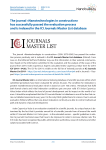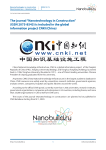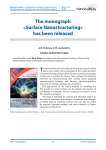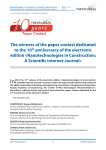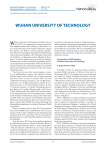Статьи журнала - Nanotechnologies in Construction: A Scientific Internet-Journal
Все статьи: 409
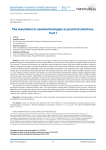
The inventions in nanotechnologies as practical solutions. Part I
Статья научная
A brief review of patents is given. The research performed by scientists, engineers and specialists in the area of nanotechnologies and nanomaterials result in increased efficiency of construction, housing sector and adjacent fields of economy. The invention «A method of introduction of single-shell and/or double-shell and/or multi-shell carbon nanotubes in adhesive additive composition for asphalt coating and application of single-shell and/or double-shell and/or multi-shell carbon nanotubes as a part of adhesive additive composition» refers to construction, in particular, to the materials used in road, airdrome and civil construction. Concentration (content) of single-shell and/or double-shell and/or multi-shell carbon nanotubes varies from 0,01% to 15% of volume of asphalt covering. The invention «A method to produce nanocomposite material» based on aluminium refers to powder metallurgy, in particular to production of metal and carbon composite materials and articles of them in different shapes and can be used in auto industry, shipbuilding, aircraft engineering and instrument manufacture and other areas. The invention «A method of low temperature application of nanocrystal coating of alpha-oxide aluminium» refers to method of production nanocrystal coating of alpha-oxide aluminium with high rate under low temperature. Coatings of aluminium oxide are characterized by high thermal resistance, chemical inaction, hardness, compression resistance, heat-insulation capacity and is widely used for protection the products exposed to high temperatures and aggressive environments. The specialists can also be interested in the following inventions in the area of nanotechnologies: device and method for production of powder materials based on nano- and microparticles through electric explosion of wire; vacuum machine for application of nanostructured coating made of material with shape memory effect on the detail surface; hierarchically reinforced heteromodular extrudable solid lubricant nanocomposite based on UHMW PE and a method to produce it; hydrogen-accumulating materials and a method to produce them et al.
Бесплатно
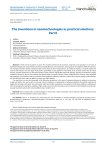
The inventions in nanotechnologies as practical solutions. Part II
Статья научная
A brief review of patents is given. The research performed by scientists, engineers and specialists in the area of nanotechnologies and nanomaterials result in increased efficiency of construction, housing sector and adjacent fields of economy. For example, invention «Elastic conductive film on the basis of silver nanoparticles», according to experts, is of great interest for science and industry. This new type of electronics potentially can be applied in many fields, such as elastic sensor skin for robot devices, portable electronics for functional clothes, elastic sensors and flexible electronic displays. Elasticity of materials is highly needed in electronic devices that contact the human body or curved surfaces. Elastic conductive film contains many annealed nanoparticles of conductive metal, in particular silver, applied on substrate. Adhesion of silver film is of great quality: when abrasion test was finished, there were no defects or there were slight defects. The specialists can also be interested in the following inventions in the area of nanotechnologies: a method to introduce single-wall and/or two-wall and/or multi-wall carbon nanotubes in composition of adhesive additives for asphalt coating and application of single-wall and/or two-wall and/or multi-wall carbon nanotubes in composition of adhesive additives; welding wire with nanocomposite coating for welding of high-tensile steel; A method to produce nanocomposite material based on aluminium; sewage treatment system with nanomodified natural sorbents et al.
Бесплатно
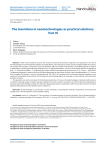
The inventions in nanotechnologies as practical solutions. Part III
Статья научная
A brief review of patents is given. The research performed by scientists, engineers and specialists in the area of nanotechnologies and nanomaterials resulted in increased efficiency of construction, housing sector and adjacent fields of economy. For example, the invention «Construction structural element» refers to the field of construction. The building element is made of a cured mixture containing the following components, wt. %: dispersed foamglass – 60–85; 25–30% alumina solution in phosphoric acid – 13–34; basalt microfiber – 2–6; fulleroid type carbon toroid-like nanoparticles (fractions from 15 to 150 nm) – 0.009–0005. The dispersed foamglass is made in the form of foamed glass beads, on the surface of which a layer of polyparaxilylene 2–5 microns thick is applied. The mixture is cured at a temperature of 160–180оC. The technical result is increased strength, toughness, crack resistance and durability at low density, that is important when building objects, for example, to create internal walls and cellular partitions in rooms. The specialists can also be interested in the following inventions in the area of nanotechnologies: composite reinforcement, a method of manufacturing composite powder material from alumina carbon nanotubes; the method of plasma deposition of nanostructured heat-shielding coating; the method of degassing tungsten nanopowder; method to produce mixtures of highly dispersed heterophase powders based on boron carbide, etc.
Бесплатно
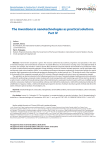
The inventions in nanotechnologies as practical solutions. Part IV
Статья научная
A brief review of patents is given. The research performed by scientists, engineers and specialists in the area of nanotechnologies and nanomaterials resulted in increased efficiency of construction, housing sector and adjacent fields of economy. For example, the invention «Carbon ceramic fiber-reinforced composite material and method for its production» refers to a class of carbon-based composite materials of heat-shielding, structural, chemical-resistant purposes, can be used under static and dynamic loads when heated to 2000оC in an oxidizing environment (aerospace engineering, construction facilities for special purposes, high-temperature electrothermal equipment, equipment for nuclear reactors, etc.). The technical result of the invention is the strength of the composite increased up to 40% in terms of flexural strength and twice in terms of compressive strength. The specialists can also be interested in the following inventions in the area of nanotechnologies: building construction elements; a method for synthesizing a composite carbon material with metal nanoparticles with transferring a part of their electron density to a carbon matrix; a method of manufacturing marker of fuel and lubricants; wastewater treatment system with nano-modified natural sorbents; nanocrystal, hydrosol of nanocrystalline cellulose and method for producing it; a method for producing membranes for ultrafiltration of aqueous media; a method of obtaining transparent ceramics of yttrium-aluminum garnet; method and device for atomic emission spectral analysis of nanoobjects, etc.
Бесплатно
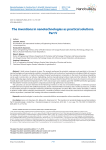
The inventions in nanotechnologies as practical solutions. Part V
Статья научная
A brief review of patents is given. The research performed by scientists, engineers and specialists in the area of nanotechnologies and nanomaterials resulted in increased efficiency of construction, housing sector and adjacent fields of economy. For example, the invention «A method to produce fireproof wood-polymer composites on the basis of secondary polyolefine» can be used in construction, car industry, shipbuilding, machine manufacturing, furniture trade and other industries. The method includes following stages: drying of composite components, mixing and heat forming of them by means of extrusion in extrusion Co- Kneader plant under treatment temperature120оС–150оС and conveyor screw rotation speed 350–450 RPM with further granulation. The obtained fire-resistant wood-polymer composite possesses high performance characteristics. The specialists can also be interested in the following inventions in the area of nanotechnologies: a method to produce strengthened nanocomposite with additional properties, anodic material for lithium-ion battery and a method to produce it, a method to rise breaking strength of composite material by preliminary impregnation of carbon fibers with carbon nanotubes, a method to produce carbon metal-containing nanostructures, a method to produce volume microscale structures from nanoparticles and a device to perform it, antistatic floor coating with carbon nanotubes and other.
Бесплатно
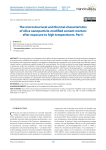
Статья научная
This study presents an investigation of the effects of high temperature on the thermal and microstructural properties of cement mortars modified with nanosilica. In the first stage of the research, the effects of nanosilica (NS) and silica fume (SF) on the hydration and compressive strength of cementitious composites were compared. In the second stage, four different types of cement mortars, containing an optimal dosage of NS, were produced. Two of them contained a normal weight aggregate (quartz or limestone), whilst two contained a heavy weight aggregate (barite or magnetite). Specimens without NS were produced for control purposes. The specimens were exposed to 300, 450, 600 and 800°C, with their post-heating properties – including thermal conductivity, specific heat, solvent absorption and cracking behavior – analyzed. The results show that NS exhibits significantly higher reactivity with cement than SF. NS accelerates the cement hydration process and contributes more significantly to the 28 and 365 day compressive strength of mortar, as compared to SF. The incorporation of NS in a composite substantially decreases the amount of CH in the mixture and leads to the production of additional C–S–H gel phase, which improves microstructure. The study also shows that NS contributes to a decrement in the thermal conductivity and density of mortar, both prior to and after heating. The incorporation of NS has a beneficial effect on decreasing the deterioration rate of mortars after heating, by decreasing absorption rate and the amount of cracks in in them.
Бесплатно

Статья научная
This study presents an investigation of the effects of high temperature on the thermal and microstructural properties of cement mortars modified with nanosilica. In the first stage of the research, the effects of nanosilica (NS) and silica fume (SF) on the hydration and compressive strength of cementitious composites were compared. In the second stage, four different types of cement mortars, containing an optimal dosage of NS, were produced. Two of them contained a normal weight aggregate (quartz or limestone), whilst two contained a heavy weight aggregate (barite or magnetite). Specimens without NS were produced for control purposes. The specimens were exposed to 300, 450, 600 and 800°C, with their post-heating properties – including thermal conductivity, specific heat, solvent absorption and cracking behavior – analyzed. The results show that NS exhibits significantly higher reactivity with cement than SF. NS accelerates the cement hydration process and contributes more significantly to the 28 and 365 day compressive strength of mortar, as compared to SF. The incorporation of NS in a composite substantially decreases the amount of CH in the mixture and leads to the production of additional C–S–H gel phase, which improves microstructure. The study also shows that NS contributes to a decrement in the thermal conductivity and density of mortar, both prior to and after heating. The incorporation of NS has a beneficial effect on decreasing the deterioration rate of mortars after heating, by decreasing absorption rate and the amount of cracks in in them.
Бесплатно
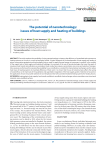
The potential of nanotechnology: issues of heat supply and heating of buildings
Статья научная
The article explores the possibility of using nanotechnology to improve the efficiency of centralized and autonomous heating systems on the way to a new technological model. A logical sequence of the development of heat supply and heating is given, conservative equipment and technologies that are used to supply thermal energy to consumers is marked. In the context of the urgent tasks of heat supply and heating of buildings, the concepts of the use of nanotechnologies that meet the goals of maximum heat transfer intensification are considered. Heat conduction analysis, concentration, size, mass and velocity of nanoparticles assesses are the basis for assessing the possibility to use nanofluids as a coolant for improving heat exchangers and to reduce heat losses in heating systems to maximize efficiency of their work. It is shown that the use of nanostructures affects the saving of coolant flow as the main task of the qualitative and quantitative regulation of the heat supply system. Attention is focused on the application of nano-structured materials in low-temperature fuel cells used decentralized heating systems for heating houses.
Бесплатно
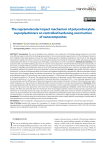
Статья научная
Introduction. The use of modifying nano-additives in the production of binding building materials is one of the most effective ways to control the technological parameters of concrete by conducting good control of the rheological characteristics reliability. Plasticizing additives increase the water-holding capacity of building compositions, which leads to the dispersed nanosystems stability. This article is focused on examining the physical and chemical mechanisms of the supramolecular effects of polycarboxylate ethers on technological and rheological characteristics of cement nanobinders. Methods and materials. This study describes controlled hardening processes of concrete nanocompositions with demanded technological characteristics in the presence of highly effective plasticizers. Moreover, this paper carries out the analysis of the innovative trends in regulating the consistency of building nanocomposites with the use of new comb-like polycarboxylate esters, which as superplasticizers allow to purposefully influence the kinetics of structure formation of cement nanocomposites. Results. Electrostatic and steric repulsion mechanisms, as well as the dispersing effects of innovative and traditional plasticizing nanoparticles, affect the adsorption and diffusion layers of the hydrated cement nanobinders ultrastructure. The most effective plasticizing properties are shown by comb-like polycarboxylate esters (CPE) with a linear chain molecular weight of ≈12000 g/mol and a length of side branches which correspond to a molecular weight of ≈750 g/mol. The supramolecular mechanism of nanosteric van der Waals repulsive forces begins to be detected at a distance of ≈11 nm, and the elasticity of the lateral branches of innovative CPE is ≈ 5 nm. Individual segments of CPE macromolecules enter the diffuse layer of dispersed nanosystems due to lateral interactions of anions of functional groups, hydrophobic fragments, etc.; they enhance the plasticizing effect of cement binders in concrete nanocompositions. Discussion. When using superplasticizing CPE, the density of concrete nanocomposites can be increased by reducing the amount of water mass to the cement mass ratio to the optimal 0.3; at the same time, technological pumpability and reliability control of the joint hardening kinetics with fillers are preserved within the framework of the technological problems system solutionsconcept. Supramolecular interaction of «anchoring» functional groups of polyacrylic acid containing solid phase cations of cement microparticles, fractal clusters of calcium hydrosilicates and simultaneous steric stabilization of polyethylene glycol radicals give the necessary rheological characteristics to construction nanocompositions and allow the construction of high-strength 55÷80 MPa building materials. Conclusions. The branched comb-like nanostructure of polycarboxylate esters exhibits effective technological characteristics of superplasticizers for concrete, building mortars and dry building mixes.
Бесплатно
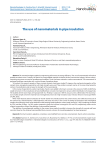
The use of nanomaterials in pipe insulation
Статья научная
The nanotechnologies applied in engineering will increase its energy efficiency. The use of nanomaterials will make it possible to reduce costs. Currently, the search for nanomodified materials is relevant for the construction industry. Various carboncontaining structures are used as nanodispersed modifiers. Taunit has been selected as carbon nanomaterial. This nanomaterial is packaged multilayer nanotubes with a conical shape of graphene layers. To conduct this research samples of foam concrete cements have been studied. To improve the mechanical properties of the cement stone, elongated nanoparticles with high strength were used. They reinforce cement mortar, at the same time being the centers of crystallization and increase the strength of the nanomaterial. In the course of experiments, carbon nanotubes «Taunit» were added to the foam concrete in the amount of 0.005–0,0005% by weight of cement. In the manufacture of nanomodified foam concrete it is important to ensure uniform distribution of nanoparticles. The studied cement stone chips were sprayed with Au / Pd alloy in a Quorum 150T ES vacuum unit in a 80/20 ratio. The microstructure of solid samples of cement material was investigated by means of a high-resolution auto-emission electron microscope Merlin of CARL ZEISS. When multi-layered carbon nanotubes of “Taunit” brand were introduced into the cement mortar, the relief microstructure of the cement was characterized by a heterogeneous and loose structure. In the course of testing the strength of the investigated samples, the following results were obtained: under bending loads applied to cement-sand mortar for 7 days, hardening increased by 35%, and after 28 days – by 30%; under compressive loads, the increase in strength is 42% and 22%, respectively, relative to the original composition without the addition of nanomodified materials. The addition of nanodispersed modifiers to the cement stone made it possible to increase the strength of concrete and foam concrete. Based on the obtained nanomodified foam concrete, a device for insulating pipelines has been proposed.
Бесплатно
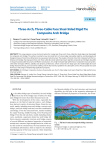
Three-Arch, Three-Cable Face Steel-Sided Rigid Tie Composite Arch Bridge
Статья научная
This essay proposes a new structural system for a large span three-arch, three-cable face steel edge main beamrigid tie composite arch bridge. The authors invented a new structural form of a steel edge main girder rigid tie, and developed and designed a key arch-bar three-dimensional six-way space node structure. The analysis of results show that: compared with the traditional arch bridge, the large span three-arch three-cable face steel-sided main beam rigid ties composite arch bridgeis beautiful in shape, hasareasonable structure and efficient construction. It is a high-strength, high-performance composite structural system, with better strength, stiffness, stability and dynamic performance, which overcomes the large span ultra-wide bridge deck arch bridge horizontal thrust, poor transverse stability, and the key technical problems of acable joint control. The proposed structural form has a wide range of engineering application prospects.
Бесплатно
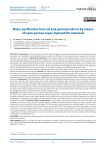
Water purification from oil and petrol products by means of nano-porous super-hydrophilic materials
Статья научная
Introduction. This article reveals the research results of physical and chemical properties of the new filtering material, evaluation of its hydrophilic and oleophobic features as well as the efficiency of oil-in-water emulsions separation in laboratory conditions and in production. Methods and materials. As the base for creation of new filtering material a natural mixture of minerals with good prevalence of silicon earth also including some small amounts of fissile hydrous silicates (mica, clay) was chosen, which provide the durability of granulated end product at reservation of porosity and hydrophilic properties of the material surface. The research used spherical shape granules of various particle size obtained by drying, granulation and firing. Prior to filtration the granules are being impregnated with water aiming to obtain a water shell around each granule, which provides granules protection from oil and petrol products contamination as well as an easy filter cleaning by backwashing in fluidization mode. For the lab testing of oil-in-water emulsions separation parameters a test rig was built. In process a set of various tool methods of physical and chemical research was used. Results. The chemical and mineral composition of the developed filtering material and the results of its X-ray-structural analysis, photomicrography of ground substrate obtained with SEM are given as well as the porous structure data (pores size distribution and aggregate pores of granules material) obtained by the method of low-temperature nitrogen adsorption. The results of laboratory and pilot testing of separating and accumulating ability of the filtering material are presented. Interpretation. The obtained data prove the fact that the developed material possesses over the prominent hydrophilic properties, while after water shell creation also over the oleophobic properties. Upon exploration of the two liquid immiscible phases separation during the filtering through the granules obtained, a significant efficiency growth of the filter after attaining the special amount of oil and petrol products retained by the filter was detected. The efficiency increase of the filter is connected with formation of a prolonged structure, which was named by the authors a “fluid net”, created by the oil and petrol products entrapped. The strings of that “fluid net” being formed in the gaps between the granules are decreasing the sizes of the passages which lets the entrapping efficiency of finer oil and petrol products droplets grow. Conclusion. The obtained nano-porous granules of the filtering material exhibit super-hydrophilic properties and based on the water shell created around them provide the following: protection of granules from contamination with oil and petrol products contained in water to be purified; effective and not decreasing over the course of time filter regeneration by means of backwashing in fluidization mode; quality of water purification from oil and petrol products at the level of the most expensive purification methods. Prospective fields of applications. The “OreFilter” technology developed has passed the pilot scale validation on the basis of more than fifty industrial objects of different industrial branches (mainly on those connected with oil production and oil refining) in Russia and abroad. The technology is now being tested on industrial objects in the Near East, Canada, US, Brazil and Australia. The industrial filtering units using “OreFilter” technology are already in operation on Russian enterprises as well as in Sweden and Germany. The experimental-industrial tests have proved the application efficiency of the technology developed: in food industry; at the detergents and soaps manufacturing plants; at mining and processing plants; at purification of ballast and bilge water at ports; at purification of polluted water after oil tankers washing; in fish farming; in seaquariums and dolphinariums.
Бесплатно
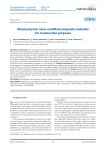
Wood-polymer nano-modified composite materials for construction purposes
Статья научная
Introduction. The advantages of nano-modified composite materials for construction purposes based on polyvinyl chloride (PVC) include enhanced strength characteristics compared to other materials [1]. Composite nanomaterials based on plant resources are versatile materials, whose properties can be modified through additives and processing technology to obtain a wide range of products in various application areas, particularly in construction, decking, outdoor and garden furniture, siding, picket fences, packaging, pallets, and much more. The research aims to investigate the influence of different additives on the technological and operational properties of the resulting composite. Nano-modified composite materials based on PVC are superior to polyolefin composites in terms of stiffness and strength, have high light-resistance as well as resistance to many chemicals, and are comparatively inexpensive as raw materials [2]. Methods and materials. The research aims to determine the preparation of composite materials that provide a highly effective stabilizing system against thermal decomposition, which increase the flow properties of the polymer melt, reduce water sorption, and impart sufficiently high outdoor stability; therefore, products made from composite materials can be successfully used in the construction area. Results. Research results have shown that the use of nanostabilizers in the technology of producing building materials can ensure preservation and ageing quality of polymer composites. They also have application potential on industrial scale. Conclusion. Investigations carried out on the use of a number of nanostabilizers, give to construction composites higher color retention and therefore increase environmental resistance of material.
Бесплатно

